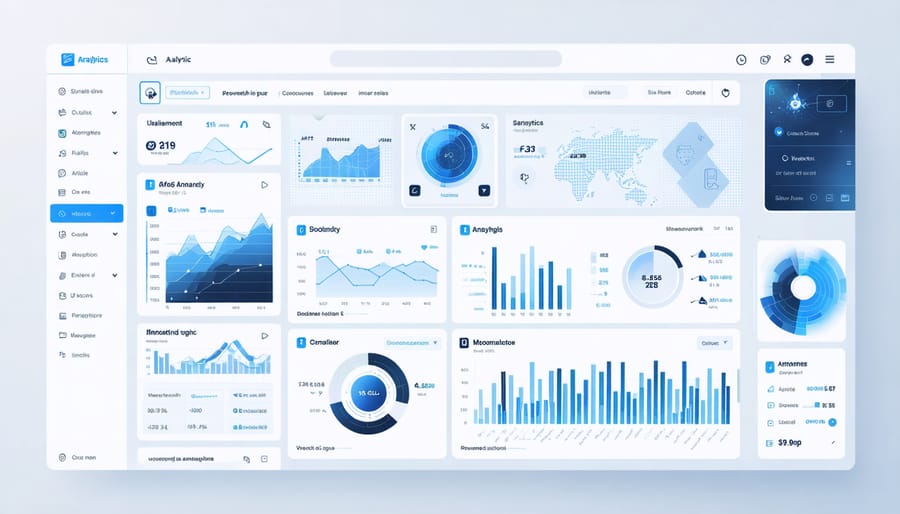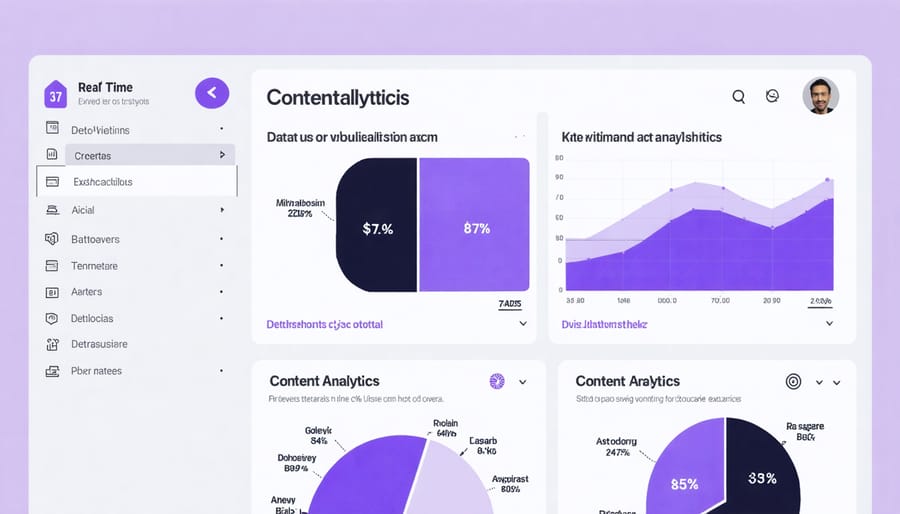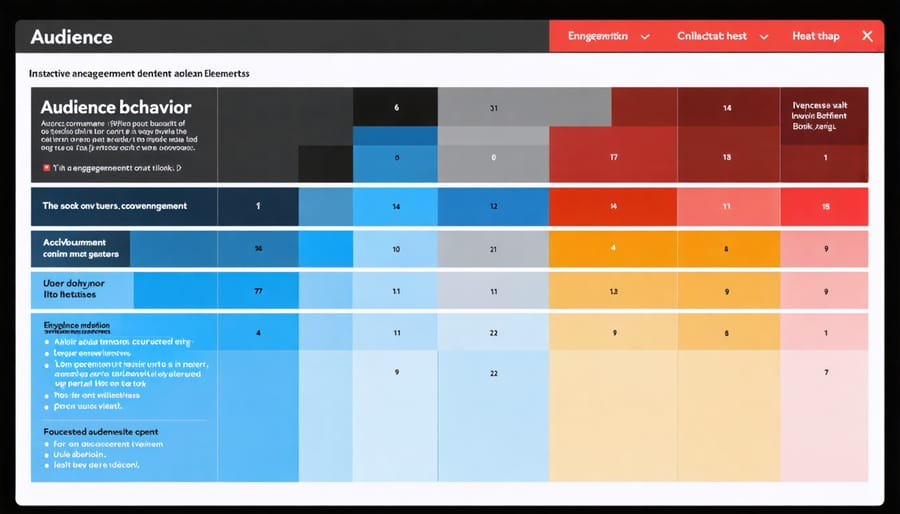AI-Powered Analytics Transform Content Marketing Measurement (Here’s How)

Transform your content strategy by mastering performance measurement through data analytics in marketing. Track conversion rates, engagement metrics, and ROI across all content channels using unified dashboards to identify top-performing assets and optimization opportunities. Modern content performance measurement demands real-time analysis of user behavior patterns, competitive benchmarking, and AI-powered predictive analytics to forecast content success.
Content measurement has evolved beyond basic pageviews and social shares. Today’s marketing professionals leverage advanced attribution models, customer journey mapping, and machine learning algorithms to understand exactly how content drives business outcomes. By combining quantitative metrics with qualitative insights from user feedback and behavior analysis, organizations can create data-driven content strategies that consistently deliver measurable results.
The key to effective measurement lies in establishing clear KPIs aligned with business objectives, implementing comprehensive tracking systems, and maintaining regular reporting cycles that drive continuous improvement. This systematic approach ensures content investments generate maximum impact while providing actionable insights for future optimization.
Real-Time Performance Tracking with AI

Automated Data Collection
Modern content performance measurement relies heavily on automated data collection systems powered by artificial intelligence. These AI-driven tools continuously monitor and gather metrics across multiple channels, eliminating the need for time-consuming manual data entry and reducing human error.
AI algorithms can track key performance indicators in real-time, from basic metrics like page views and engagement rates to more complex data points such as user behavior patterns and content sentiment analysis. This automation enables marketing teams to focus on strategy and optimization rather than data gathering.
The technology can also identify trends and correlations that might be missed by human analysis alone. For instance, AI systems can automatically detect which content formats perform best at specific times of day or which topics generate the highest user engagement across different platforms.
Many popular marketing platforms now incorporate AI-powered analytics dashboards that provide instant access to comprehensive performance data. These tools often include automated reporting features that can generate customized reports based on predetermined metrics, making it easier for teams to share insights with stakeholders and make data-driven decisions quickly.
Dynamic Performance Indicators
Modern AI-powered analytics tools can track and analyze content performance metrics in real-time, providing invaluable insights for quick decision-making. These dynamic indicators go beyond traditional static metrics, offering a comprehensive view of how content performs across multiple channels simultaneously.
Key performance indicators that can be monitored in real-time include engagement rates, scroll depth, time on page, and social sharing velocity. AI systems can also track user behavior patterns, such as click-through paths, conversion points, and content abandonment rates. This immediate feedback allows marketers to make data-driven adjustments to their content strategy on the fly.
Advanced AI algorithms can also measure sentiment analysis, tracking how audiences respond emotionally to content across different platforms. Real-time monitoring of backlink generation, social media mentions, and referral traffic provides a clear picture of content reach and authority building.
Most importantly, these dynamic indicators can be customized to align with specific business goals, whether that’s lead generation, brand awareness, or direct sales. By setting up automated alerts for significant metric changes, teams can respond promptly to both opportunities and challenges in their content performance.
Predictive Analytics for Content Success
Content Performance Forecasting
Modern content strategies are increasingly relying on predictive analytics for marketing to forecast content performance before publication. AI-powered tools can now analyze historical data, audience behavior patterns, and content characteristics to predict engagement rates, conversion potential, and overall content success with remarkable accuracy.
These forecasting capabilities enable marketing teams to optimize their content before launch by identifying potential performance issues and opportunities for improvement. Key predictive metrics often include expected click-through rates, time on page, social sharing probability, and likely conversion outcomes.
To leverage content performance forecasting effectively, businesses should:
1. Gather comprehensive historical performance data
2. Identify key success metrics specific to their goals
3. Use AI tools to analyze content elements against past performance
4. Implement suggested optimizations before publication
5. Monitor actual versus predicted performance to refine forecasting accuracy
The real value of AI-driven forecasting lies in its ability to reduce resource waste by identifying potentially underperforming content early in the creation process. This allows teams to make data-driven decisions about content investments and adjust their strategies proactively rather than reactively.
While no prediction system is perfect, modern AI forecasting tools typically achieve accuracy rates of 70-85% in predicting content performance, making them invaluable for content strategy optimization and resource allocation.

Automated Content Optimization
Artificial Intelligence has revolutionized content optimization by providing real-time suggestions based on performance metrics. Modern AI systems analyze multiple data points simultaneously, including engagement rates, conversion metrics, and user behavior patterns, to recommend actionable improvements that can enhance content effectiveness.
These AI-powered tools continuously monitor content performance and automatically flag areas that need attention. For instance, when a blog post’s engagement drops, the system might suggest updating outdated statistics, improving readability scores, or adjusting headline formats based on successful content patterns. This proactive approach eliminates the need for manual monitoring and enables quick response to performance changes.
The optimization process typically involves analyzing:
– User engagement patterns
– Time-on-page metrics
– Scroll depth
– Click-through rates
– Social sharing metrics
– Conversion performance
AI algorithms can identify content elements that consistently perform well across your platform and recommend similar approaches for underperforming pieces. For example, if data shows that listicle-style articles generate 50% more engagement, the system might suggest restructuring certain posts to match this format.
Most modern content management systems now incorporate AI-driven optimization features that provide suggestions while you’re creating content, ensuring better performance from the start. This predictive approach helps content creators make data-backed decisions before publication, significantly reducing the need for post-publication adjustments.
Advanced Audience Analysis

Behavioral Pattern Recognition
Artificial Intelligence has revolutionized how we understand audience behavior by identifying complex interaction patterns that might go unnoticed through traditional analytics. Modern AI systems continuously monitor and analyze how users engage with content across multiple touchpoints, creating detailed behavioral maps and predictive models.
These systems track various user actions, including scroll depth, time spent on specific sections, click patterns, and content sharing behaviors. By processing this data in real-time, AI can identify trends such as optimal content length for different audience segments, preferred consumption times, and content formats that drive the highest engagement.
The pattern recognition process works on multiple levels. At the micro level, it analyzes individual user journeys, tracking how each person moves through your content ecosystem. At the macro level, it aggregates this data to reveal broader audience segments and behavioral trends. This dual approach enables more precise content targeting and personalization.
Key behavioral indicators that AI systems typically monitor include:
– Content consumption sequences
– Navigation patterns
– Interaction frequency
– Abandonment points
– Cross-device usage patterns
– Social sharing behaviors
By understanding these patterns, businesses can optimize their content strategy in real-time, adjusting elements like content delivery timing, format selection, and topic focus to match audience preferences. This data-driven approach leads to more effective content performance and higher engagement rates.
Personalization Insights
Modern content performance measurement goes beyond basic analytics when you leverage AI-driven content personalization capabilities. By analyzing user behavior patterns, demographic data, and engagement metrics, AI algorithms can identify distinct audience segments and their preferences, enabling highly targeted content delivery.
These personalization insights help marketers understand which content resonates with specific audience groups. For instance, B2B decision-makers might engage more with detailed case studies, while general consumers prefer quick-read blog posts. AI systems can automatically track these preferences and adjust content distribution accordingly.
Key personalization metrics to monitor include:
– Content format preferences by audience segment
– Topic engagement patterns
– Optimal content length for different user groups
– Preferred consumption times
– Device-specific engagement rates
To implement effective personalization:
1. Collect comprehensive user data across all channels
2. Use AI tools to identify behavioral patterns
3. Create audience segments based on engagement data
4. Develop targeted content strategies for each segment
5. Monitor and adjust based on performance feedback
The real power of personalization lies in its ability to continuously learn and adapt. As more data is collected, AI systems refine their understanding of audience preferences, leading to increasingly precise content targeting and improved performance metrics.
Implementation Strategies
Tool Selection and Integration
Selecting the right measurement tools is crucial for tracking content performance effectively. Start by assessing your specific needs, including budget constraints, team size, and technical expertise. Consider integrating AI performance management tools that can automate data collection and analysis while providing real-time insights.
Look for platforms that offer comprehensive analytics dashboards, customizable reporting features, and integration capabilities with your existing marketing stack. Key features should include audience engagement metrics, conversion tracking, and content attribution modeling. Popular options include Google Analytics 4, SEMrush, and HubSpot Analytics, each offering unique strengths for different business needs.
When implementing new tools, follow these steps:
1. Start with a pilot program to test functionality
2. Train team members thoroughly on tool usage
3. Establish clear processes for data collection and reporting
4. Set up automated alerts for key performance indicators
5. Regular review and optimization of tool settings
Ensure your chosen tools can scale with your business growth and provide the flexibility to adapt to changing market conditions. Consider tools that offer API access for custom integrations and automated workflow creation. Remember to regularly evaluate tool performance and ROI to maintain an efficient measurement ecosystem.
Performance Monitoring Framework
A robust performance monitoring framework combines automated data collection with intelligent analysis to track your content’s impact effectively. Start by establishing clear key performance indicators (KPIs) aligned with your business objectives, such as engagement rates, conversion metrics, and audience growth targets.
Implement an AI-powered analytics dashboard that consolidates data from multiple sources, including social media platforms, website analytics, and email marketing tools. This centralized approach enables real-time monitoring and automated reporting, saving valuable time while ensuring consistent measurement across all content channels.
Set up automated alerts for significant performance changes, allowing quick responses to both opportunities and challenges. Configure your monitoring system to track not just basic metrics but also advanced indicators like content decay rates, audience sentiment, and competitive positioning.
Create custom reporting templates that automatically generate insights for different stakeholders. Marketing teams need detailed performance breakdowns, while executives might prefer high-level impact summaries. Your framework should accommodate both through automated report generation.
Integrate machine learning algorithms to identify patterns and predict content performance trends. This predictive capability helps optimize content scheduling and resource allocation. Regular system audits ensure your framework evolves with changing business needs and emerging measurement technologies.
Remember to include qualitative feedback mechanisms alongside quantitative metrics, providing a complete picture of content effectiveness and audience response.
As we look to the future of content measurement, AI technology continues to revolutionize how businesses track and optimize their content performance. The integration of artificial intelligence into content analytics tools offers unprecedented accuracy, speed, and depth of insights that were previously unattainable through manual methods alone.
The benefits are clear: automated performance tracking saves valuable time, predictive analytics help anticipate content success, and machine learning algorithms continuously improve measurement accuracy. For business owners and marketing professionals, this means more informed decision-making, better resource allocation, and higher ROI on content investments.
Looking ahead, we can expect AI-driven content measurement to become even more sophisticated, with enhanced natural language processing capabilities, real-time optimization suggestions, and deeper audience behavior analysis. However, the key to success will always lie in balancing automated insights with human creativity and strategic thinking.
By embracing these technological advances while maintaining focus on core business objectives, organizations can build more effective content strategies that truly resonate with their target audience and drive measurable results. The future of content measurement is not just about collecting data – it’s about turning that data into actionable intelligence that powers business growth.
Leave a Reply